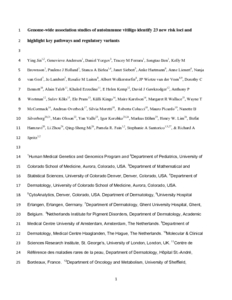Jin, Y;
Bennett, DC;
Spritz, RA;
Andersen, G;
Yorgov, D;
Ferrara, TM;
Ben, S;
Brownson, KM;
Holland, PJ;
Birlea, SA;
et al.
Jin, Y; Bennett, DC; Spritz, RA; Andersen, G; Yorgov, D; Ferrara, TM; Ben, S; Brownson, KM; Holland, PJ; Birlea, SA; Siebert, J; Hartmann, A; Lienert, A; van Geel, N; Lambert, J; Luiten, RM; Wolkerstorfer, A; Wietze van der Veen, JP; Taïeb, A; Ezzedine, K; Helen Kemp, E; Gawkrodger, DJ; Weetman, AP; Koks, S; Prans, E; Kingo, K; Karelson, M; Wallace, MR; McCormack, WT; Overbeck, A; Moretti, S; Colucci, R; Picardo, M; Silverberg, NB; Olsson, M; Valle, Y; Korobko, I; Bohms, M; Lim, HW; Hamzavi, I; Zhou, L; Mi, QS; Fain, PR; Santorico, SA
(2016)
Genome-wide association studies of autoimmune vitiligo identify 23 new risk loci and highlight key pathways and regulatory variants.
Nature Genetics, 48 (11).
pp. 1418-1424.
ISSN 1546-1718
https://doi.org/10.1038/ng.3680
SGUL Authors: Bennett, Dorothy Catherine
![[img]](https://openaccess.sgul.ac.uk/108278/1.hassmallThumbnailVersion/Author%20acc%20version%20Spritz%20NG%202016.pdf)  Preview |
|
PDF
Accepted Version
Available under License ["licenses_description_publisher" not defined].
Download (6MB)
| Preview
|
Abstract
Vitiligo is an autoimmune disease in which depigmented skin results from the destruction of melanocytes1, with epidemiological association with other autoimmune diseases2. In previous linkage and genome-wide association studies (GWAS1 and GWAS2), we identified 27 vitiligo susceptibility loci in patients of European ancestry. We carried out a third GWAS (GWAS3) in European-ancestry subjects, with augmented GWAS1 and GWAS2 controls, genome-wide imputation, and meta-analysis of all three GWAS, followed by an independent replication. The combined analyses, with 4,680 cases and 39,586 controls, identified 23 new significantly associated loci and 7 suggestive loci. Most encode immune and apoptotic regulators, with some also associated with other autoimmune diseases, as well as several melanocyte regulators. Bioinformatic analyses indicate a predominance of causal regulatory variation, some of which corresponds to expression quantitative trait loci (eQTLs) at these loci. Together, the identified genes provide a framework for the genetic architecture and pathobiology of vitiligo, highlight relationships with other autoimmune diseases and melanoma, and offer potential targets for treatment.
Statistics
Item downloaded times since 11 Oct 2016.
Actions (login required)
 |
Edit Item |


